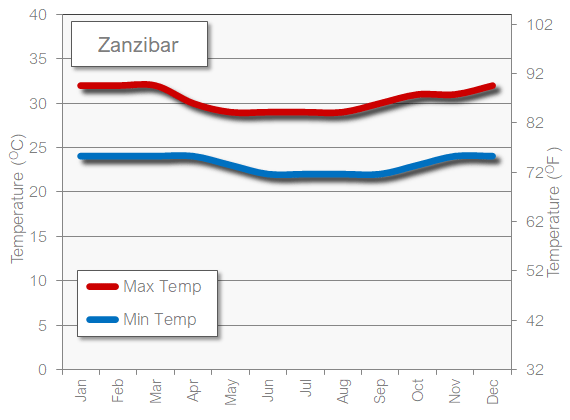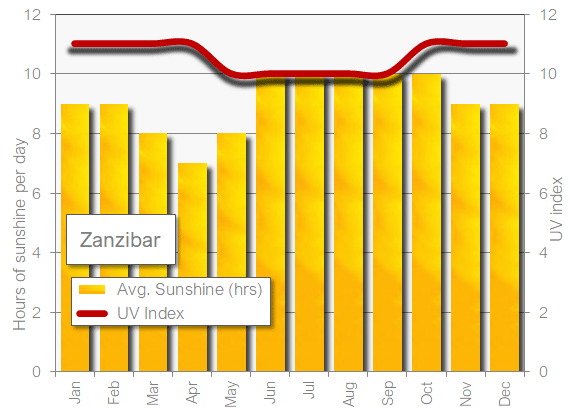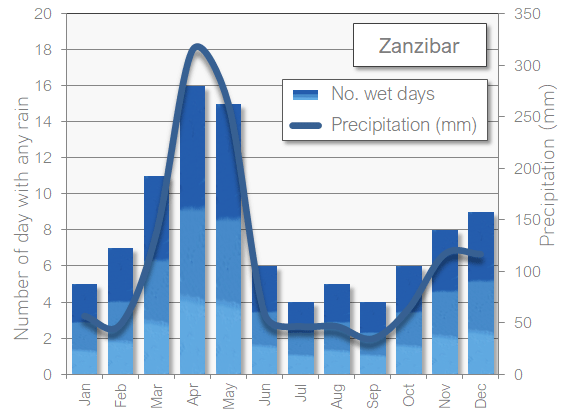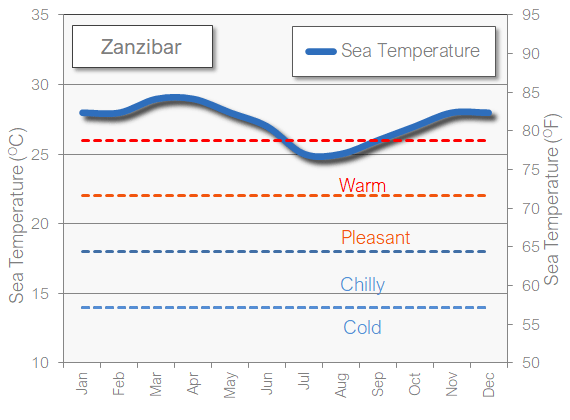Zanzibar in November: the weather and best activities for your holiday
Zanzibar, the spice island archipelago off Tanzania's coast, offers an intoxicating blend of African, Arabic, Persian, and European influences that captivate visitors from around the world. This semi-autonomous region comprises several islands, with Unguja (commonly called Zanzibar Island) being the main tourist destination, featuring Stone Town's UNESCO World Heritage sites, pristine beaches, and aromatic spice plantations that have shaped its identity for centuries.
November marks the beginning of Zanzibar's short rainy season, making it a quieter time to visit with fewer crowds and lower accommodation prices. Whilst you'll encounter occasional rainfall and higher humidity, this transitional month can still offer rewarding experiences for travellers seeking authentic cultural encounters, excellent value, and the island's characteristic warmth without the peak season masses that descend during December through February.
Overview of Zanzibar's Climate in November
November in Zanzibar represents a shift from the dry season into the 'Vuli' or short rainy season, bringing increased humidity and intermittent tropical showers that typically arrive in short, intense bursts rather than prolonged downpours.
The month maintains the island's characteristic tropical warmth whilst introducing refreshing rainfall that revitalises the landscape after the drier months, creating lush vegetation and filling the air with the earthy petrichor that follows African rains. Despite the precipitation, you'll still experience plenty of sunshine between showers, as the weather patterns tend to follow a predictable rhythm of clear mornings, possible afternoon storms, and pleasant evenings.

November temperatures in Zanzibar remain consistently warm and tropical, with daytime maximums typically reaching 30°C to 32°C (86°F to 90°F), creating conditions that feel quite hot, particularly when combined with the rising humidity levels. Night-time temperatures rarely drop below 23°C to 25°C (73°F to 77°F), meaning you'll experience warm evenings that require minimal covering even after sunset. The temperature remains remarkably stable throughout the month, with little variation between the beginning and end of November, though the perceived temperature can feel considerably higher due to humidity levels that often exceed 80%.
These conditions create a sultry, tropical atmosphere that some visitors find energising whilst others may find somewhat oppressive, particularly during midday hours when the combination of heat and moisture reaches its peak.

During November, Zanzibar enjoys approximately 12 hours of daylight, with sunrise occurring around 6:00 AM and sunset at roughly 6:15 PM, providing ample time for both morning and afternoon activities. Despite the onset of the rainy season, you can still expect around 7 to 8 hours of sunshine daily, as rainfall typically occurs in short, dramatic bursts rather than day-long drizzle.
The cloud cover tends to build throughout the day, with mornings often starting crystal clear before cumulus clouds gather in the afternoon, creating spectacular sunset opportunities when the sun breaks through the dramatic cloud formations. These atmospheric conditions produce some of the most photogenic skies of the year, with towering thunderheads creating magnificent backdrops against the Indian Ocean.

November receives an average of 150-200mm of rainfall spread across approximately 10-12 rainy days, though these figures can vary considerably from year to year. The rain typically arrives as short, intense tropical downpours lasting 30 minutes to an hour, often in the late afternoon or evening, rather than persistent all-day rainfall. Humidity levels climb significantly during this month, often reaching 85-90%, creating a sticky, tropical atmosphere that can make physical activities more challenging during the heat of the day.

The Indian Ocean surrounding Zanzibar maintains delightfully warm temperatures in November, typically ranging from 28°C to 29°C (82°F to 84°F), making it absolutely perfect for swimming, snorkelling, and diving activities. These bath-like waters provide comfortable conditions for extended time in the sea without the need for wetsuits, even during early morning or late afternoon swims.
Packing Tips and Recommendations for Zanzibar
When packing for your November holiday in Zanzibar, prioritise lightweight, breathable clothing in natural fibres like cotton and linen that will help you stay comfortable in the humid conditions. Essential items include a light waterproof jacket or compact umbrella for sudden downpours, quick-drying clothing that won't stay damp in the humidity, reef-safe sunscreen, insect repellent (mosquitoes are more active during the rainy season), and sandals or water-resistant footwear that can handle wet conditions.
When to Visit Zanzibar
The best months to visit Zanzibar are typically June through October and December through February, when the weather conditions are most favourable for beach holidays and outdoor activities. June through October represents the long dry season, offering cooler temperatures (by Zanzibar standards), minimal rainfall, and perfect conditions for diving and snorkelling with excellent underwater visibility. These months also coincide with the Great Migration in nearby Tanzania, making it ideal for combining a beach holiday with a safari adventure. The constant trade winds during this period provide natural air conditioning and keep mosquito populations lower.
When Not to Visit Zanzibar
The least favourable time to visit Zanzibar is during the long rainy season from March through May, particularly April, which receives the heaviest rainfall and can experience flooding in some areas. During these months, many hotels and restaurants close for annual maintenance, boat trips are frequently cancelled due to rough seas, and the constant humidity and rainfall can make sightseeing uncomfortable and sometimes impossible. The heavy rains can also make roads impassable, particularly in rural areas, limiting your ability to explore the island's attractions.
The Best Activities and Sights of Zanzibar in November
Exploring Stone Town's Cultural Heritage:
November's occasional showers and fewer tourists create perfect conditions for wandering through Stone Town's narrow alleyways and discovering its rich history. Visit the House of Wonders, the Old Fort, and the former slave market to understand Zanzibar's complex past. The cooler periods after rain showers make walking tours more comfortable, and you'll have better opportunities to interact with locals and explore the bustling Darajani Market without the usual crowds. Consider timing your visit to coincide with the evening food market at Forodhani Gardens, where the post-rain atmosphere is particularly atmospheric.
Spice Farm Tours:
The beginning of the rainy season brings Zanzibar's spice plantations to life, making November an excellent time for spice tours. The recent rains enhance the fragrances of cinnamon, nutmeg, cloves, and vanilla, whilst fruit trees begin bearing seasonal produce. These tours typically include lunch featuring traditional Swahili cuisine and demonstrations of how spices are harvested and processed. The lush, green conditions create beautiful photographic opportunities, and the occasional shower adds authenticity to the tropical plantation experience.
Beach Relaxation at Nungwi and Kendwa:
The northern beaches of Nungwi and Kendwa are less affected by tides than other parts of the island, making them ideal for November visits when weather patterns can be unpredictable. These areas offer excellent swimming conditions regardless of tide levels, and their position often means they receive less rainfall than the eastern coast. The beaches are noticeably quieter in November, allowing you to enjoy pristine white sands and turquoise waters without fighting for space.
Jozani Forest and Red Colobus Monkeys:
The Jozani Chwaka Bay National Park becomes particularly vibrant in November as the rains rejuvenate the forest ecosystem. This is the only place to see the endemic Zanzibar red colobus monkeys, and the cooler, post-rain conditions make wildlife more active. The forest's mangrove boardwalk is especially impressive during this season, with high water levels creating mirror-like reflections. Early morning visits offer the best monkey sightings and most comfortable temperatures.
Snorkelling and Diving at Mnemba Atoll:
Whilst visibility might be slightly reduced compared to the dry season, November still offers excellent diving and snorkelling conditions at Mnemba Atoll. The warm water temperatures are perfect for extended time in the water, and you might encounter seasonal visitors like whale sharks and manta rays. The reduced tourist numbers mean less crowded dive sites and more personalised attention from dive operators, often at discounted rates.
Prison Island (Changuu Island) Day Trip:
A short boat ride from Stone Town, Prison Island offers a perfect half-day excursion that can be easily adjusted around November's weather patterns. Home to giant Aldabra tortoises, some over 150 years old, the island also features excellent snorkelling opportunities and a fascinating history as a former prison and quarantine station. The journey provides spectacular views of Stone Town from the water, particularly dramatic with November's cloud formations.
Sunset Dhow Cruises:
November's dramatic skies create spectacular sunset conditions, making traditional dhow cruises particularly memorable. These sailing expeditions typically depart in the late afternoon when rainfall is less likely, offering a romantic and peaceful way to experience the Indian Ocean. Many cruises include fresh seafood, tropical fruits, and the opportunity to swim in the warm waters as the sun sets. The combination of traditional sailing, warm evening temperatures, and dramatic skies makes this a quintessential Zanzibar experience that's actually enhanced by November's atmospheric conditions.